Intel X25-V in RAID-0: Faster than X25-M G2 for $250?
by Anand Lal Shimpi on March 29, 2010 8:59 PM ESTOverall System Performance using PCMark Vantage
Next up is PCMark Vantage, another system-wide performance suite. For those of you who aren’t familiar with PCMark Vantage, it ends up being the most real-world-like hard drive test I can come up with. It runs things like application launches, file searches, web browsing, contacts searching, video playback, photo editing and other completely mundane but real-world tasks. I’ve described the benchmark in great detail before but if you’d like to read up on what it does in particular, take a look at Futuremark’s whitepaper on the benchmark; it’s not perfect, but it’s good enough to be a member of a comprehensive storage benchmark suite. Any performance impacts here would most likely be reflected in the real world.

Intel had been falling behind in the PCMark Vantage charts thanks to the SandForce and Crucial drives, but RAIDing these two X25-Vs makes up for a lot of lost time. Overall performance is basically on par with the entry level SandForce drives, but behind the C300 on a 6Gbps controller. The rest of the tests have the X25-V landing either in the middle or near the top of the charts, not bad for $250.
The memories suite includes a test involving importing pictures into Windows Photo Gallery and editing them, a fairly benign task that easily falls into the category of being very influenced by disk performance.
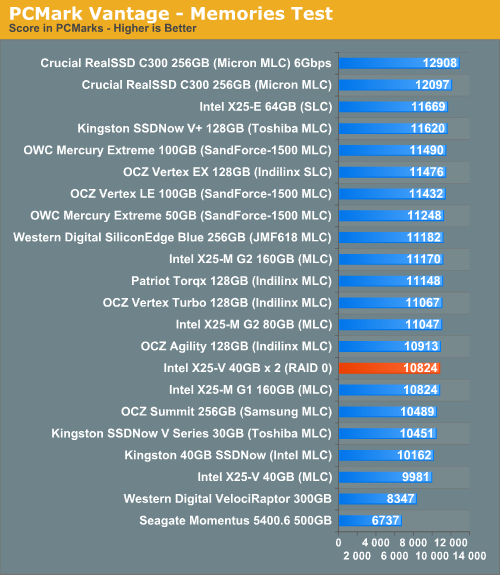
The TV and Movies tests focus on on video transcoding which is mostly CPU bound, but one of the tests involves Windows Media Center which tends to be disk bound.
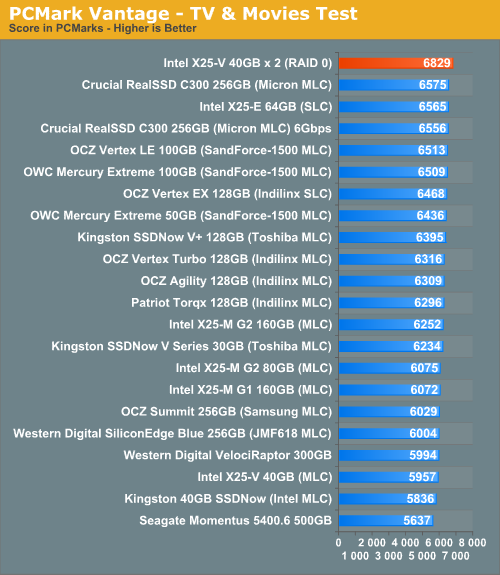
The gaming tests are very well suited to SSDs since they spend a good portion of their time focusing on reading textures and loading level data. All of the SSDs dominate here, but as you'll see later on in my gaming tests the benefits of an SSD really vary depending on the game. Take these results as a best case scenario of what can happen, not the norm.
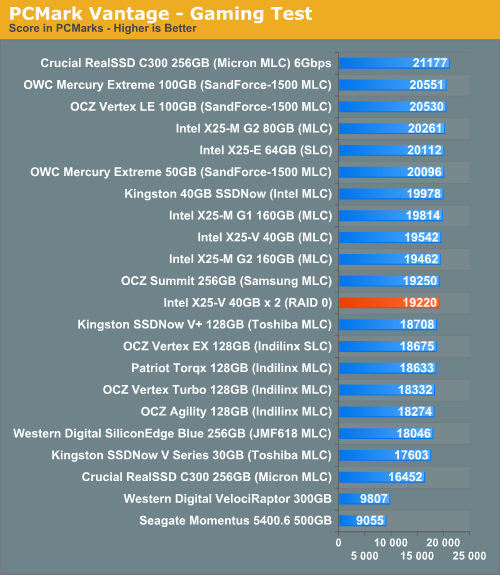
In the Music suite the main test is a multitasking scenario: the test simulates surfing the web in IE7, transcoding an audio file and adding music to Windows Media Player (the most disk intensive portion of the test).
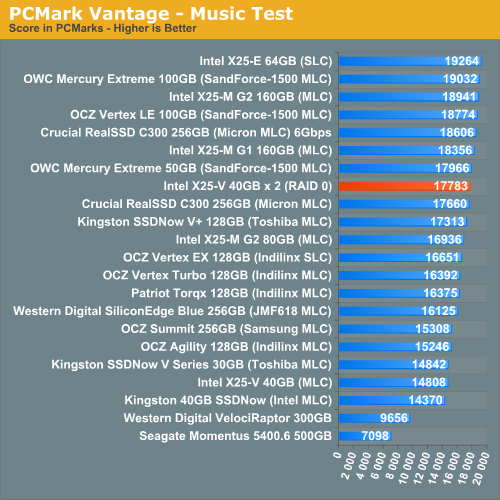
The Communications suite is made up of two tests, both involving light multitasking. The first test simulates data encryption/decryption while running message rules in Windows Mail. The second test simulates web surfing (including opening/closing tabs) in IE7, data decryption and running Windows Defender.
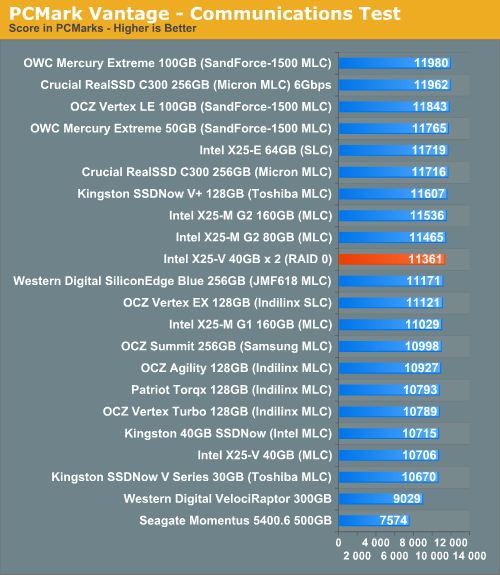
I love PCMark's Productivity test; in this test there are four tasks going on at once, searching through Windows contacts, searching through Windows Mail, browsing multiple webpages in IE7 and loading applications. This is as real world of a scenario as you get and it happens to be representative of one of the most frustrating HDD usage models - trying to do multiple things at once. There's nothing more annoying than trying to launch a simple application while you're doing other things in the background and have the load take forever.
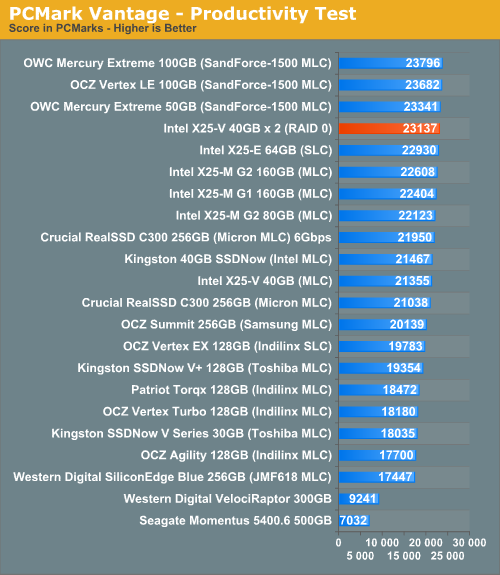
The final PCMark Vantage suite is HDD specific and this is where you'll see the biggest differences between the drives:











87 Comments
View All Comments
7Enigma - Tuesday, March 30, 2010 - link
So then why doesn't the major players offer this type of tool that works in the background? You'd have a little background task that once a week @ 2am does this when it detects no disk activity and TRIM wouldn't be important except in very rare circumstances where the drive gets no downtime (say server). Just like an unobtrusive virus scan or more apt a SSD defrag!?I have an G2 Intel 80gig and even though I have the latest firmware that supposedly TRIM's on it's own I once a month use the little toolbox utility to manually TRIM. It would be very nice if they offered a program like this to the G1 owners that they basically slapped in the face....
This is along the same lines as GPUTool. For my 4870 which runs hot at idle for no reason I can drop down 40-80 watts just by downclocking and yet it takes a 3rd party to offer this?
Bolas - Tuesday, March 30, 2010 - link
I thought TRIM was enabled for RAID now, due to a new firmware patch to the Intel chipset?!? Wouldn't that entirely change the outcome of this article?WC Annihilus - Tuesday, March 30, 2010 - link
No. As per Makaveli's reply to GDM, the new Intel drivers do NOT enable TRIM for RAID. They only allow pass through to SSDs not in an array, ie single SSD + RAID hard drives, TRIM now makes it to the SSDRoomraider - Wednesday, March 31, 2010 - link
New Intel chipset drivers do in fact enable trim only with raid-o array in windows 7. Read the documentation properly. It says any trim enabled SSD in Raid -0 only with Windows 7.jed22281 - Friday, April 2, 2010 - link
"New Intel chipset drivers do in fact enable trim only with raid-o array in windows 7. Read the documentation properly. It says any trim enabled SSD in Raid -0 only with Windows 7. "Where's this doco?
Thank-you very much.
Roomraider - Wednesday, March 31, 2010 - link
You my friend are absolutely correct. My read trippled my write more than doubled with 2xM 160 g2'. With trim verified enabled & working.AnalyticalGuy2 - Tuesday, March 30, 2010 - link
Great points and questions GullLars!! Don't give up!!
What about the possible merits of keeping the drives independent? At the very least, you get to keep Trim. And maybe there is an advantage to having 2 independent data paths leading to the drives? Or to having 2 independent controllers?
My goal is to minimize the time it takes to: boot Windows 7, allow the anti-virus to scan startup files and download updates, and load several applications into RAM.
Question: Would this be faster with:
A) One Intel 160GB G2 SSD (by the way, a 10-channel controller, right?)
B) Two independent (i.e., no RAID involved) Intel 80GB G2 SSDs -- One for Win 7 and the other for anti-virus and applications? (by the way, each SSD has a 10-channel controller, for a total of 20 channels?)
GullLars - Tuesday, March 30, 2010 - link
B would be faster, since each of the drives can then work independently in parallell. If you do something that hits both drives to read sequentially at the same time, you get 400+ MB/s read.A guy on a forum i frequent tried using W7 software RAID in hope of getting TRIM on Intel SSDs, it didn't work. Performance was comparable to ICH10R RAID.
I would still reccomend using the two x25-M 80GB in RAID over your option B, since then you always get the doubling of sequential performance. Write degradation whitout TRIM is not a problem in most realistic cases when you're RAIDing, and you likely won't notice anything. If you should notice anything, writing a large file to all free space untill you have written 2-3x of the capasity will likely restore the performance to simelar levels as fresh. You can also increase the spare area a bit and greatly reduce the impact of random writes on performance. I would consider partitioning 2x x25-M 80GB to 140GiB if you anticipate a lot of random writes and few sequential, or just is afraid of performance degradation.
Beanwar - Tuesday, March 30, 2010 - link
Anand, have you considered using Windows software RAID on two of these drives? If you're not using the hardware RAID, you should be able to pass TRIM commands to the drives, and given that even the newest applications out there aren't going to be sending all CPU cores to 100%, it's not like the overhead is going to be all that bad. Just a thought.xyxer - Tuesday, March 30, 2010 - link
Don't intel rapid storage 9.6.0.1014 support TRIM ? http://www.hardwarecanucks.com/news/cpu/intel-chip...